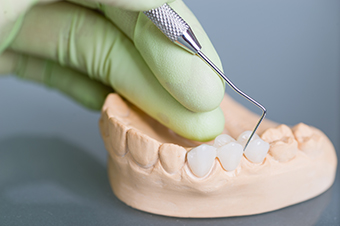 10 Mar 2024
10 Mar 2024
In dentistry, the evolution of restorative materials has offered more choices than ever for dental bridges and crowns. From the aesthetic appeal of porcelain and zirconium to the traditional durability of gold, each material offers advantages. Understanding the pros and cons of these materials is crucial in making an informed decision for your oral health.
Whether you’re after the natural look or the longevity of the restoration, the right choice varies depending on the specific needs of each tooth and patient. This guide will help you navigate the options available, shedding light on the benefits, suitability, and potential drawbacks of the most commonly used materials in dental restorations.
Gold Dental Bridges and Crowns
Benefits: Gold has long been valued in dentistry for its exceptional durability and biocompatibility. It can withstand biting forces well and minimizes wear on opposing teeth. Gold’s malleability makes it an excellent choice for precisely fitting restorations that match the intricate contours of the tooth.
Best For: Gold is ideal for back teeth where the strength of the restoration is paramount, and aesthetics are less of a concern. Its durability is suited for areas of intense pressure, such as the molars.
Potential Drawbacks: The metallic colour is the primary drawback, making gold less suitable for front teeth or where a natural appearance is crucial. Additionally, the cost of gold can be higher compared to other materials.
May Not Be Suitable For: Those who prioritize aesthetics, especially for front teeth restorations.
Full Porcelain Dental Bridges and Crowns
Benefits: Porcelain offers a remarkable aesthetic appeal, closely mimicking the natural translucency and colour of tooth enamel. It’s an excellent choice for front-tooth restorations where cosmetic appearance is paramount. Porcelain is also highly resistant to staining, ensuring your restoration maintains its colour over time.
Best For: Front teeth or visible areas where cosmetic appearance is critical. Porcelain offers the best match to natural tooth enamel.
Potential Drawbacks: While strong, porcelain can be more brittle than metal-based crowns and may chip more easily, making it less ideal for areas under heavy bite pressure.
May Not Be Suitable For: Patients who have a habit of grinding their teeth or those requiring restorations on teeth subjected to heavy biting forces.
Porcelain Fused to Gold
Benefits: Combining the aesthetic appeal of porcelain with the strength and durability of gold, porcelain fused to gold crowns and bridges offer a balanced solution. They provide excellent structural integrity for the restoration, alongside a natural-looking appearance that can be matched to the surrounding teeth.
Best For: This material compromises the aesthetic demands of front teeth and the durability needed for back teeth. It is suited for patients looking for a balance between appearance and strength.
Potential Drawbacks: The porcelain can still chip, exposing the gold beneath and affecting the aesthetic. Additionally, the cost can be higher due to the inclusion of gold.
May Not Be Suitable For: Individuals with metal allergies or those seeking a metal-free restoration.
Porcelain Fused to Zirconia
Benefits: This combination harnesses the aesthetic benefits of porcelain and the strength of zirconia, offering a strong and visually appealing solution. Zirconia’s white colour and transparency make it an ideal base for porcelain, resulting in restorations that boast a natural appearance with enhanced durability.
Best For: Those seeking a strong yet aesthetic option. Suitable for both front and back teeth, this material offers a great balance of appearance and function.
Potential Drawbacks: The bonding between porcelain and zirconia can sometimes be a weak point, with the potential for porcelain to chip away from the zirconia base.
May Not Be Suitable For: Those with very weak remaining tooth structure, as the preparation can be more extensive.
Dental Composite
Benefits: Composite materials offer a versatile and conservative option for dental restorations. They bond securely to the tooth structure, allowing for minimal tooth preparation. Composites can be easily shaped and polished to match the surrounding teeth, making them suitable for aesthetic and functional restorations.
Best For: Small to medium restorations where minimal invasiveness and preservation of tooth structure are priorities. Ideal for patients seeking quick and cost-effective solutions.
Potential Drawbacks: Composites may not be as durable as porcelain or metal options, requiring replacement more frequently. They’re also more prone to staining compared to other materials.
May Not Be Suitable For: Large restorations or areas under high chewing pressure.
How to Make the Final Decision
Choosing the right material for your dental bridge or crown involves considering several factors, including the location of the tooth, aesthetic desires, budget, and overall oral health. For each material, discussing the specific circumstances with a dentist in Mississauga is crucial to finding an option that aligns with both visual desires and functional needs. Discussing your options can help you make an informed decision.
Get a Complimentary Consultation for Expert Advice on Dental Bridges
 For those exploring dental bridge or crown options, Trillium Smile Dentistry offers a complimentary consultation to help guide you through your choices. With a wide range of dental bridge services, our team is dedicated to providing expert advice tailored to your needs. Discover how we can help restore your smile by scheduling a consultation today!
For those exploring dental bridge or crown options, Trillium Smile Dentistry offers a complimentary consultation to help guide you through your choices. With a wide range of dental bridge services, our team is dedicated to providing expert advice tailored to your needs. Discover how we can help restore your smile by scheduling a consultation today!
